
3
HNUE JOURNAL OF SCIENCE
Educational Sciences 2024, Volume 69, Issue 5B, pp. 3-16
This paper is available online at http://hnuejs.edu.vn/es
DOI: 10.18173/2354-1075.2024-0131
FOUR PERSPECTIVES ON TWO FUNDAMENTAL CONCEPTS - MATHEMATICS
AND PHYSICS TEACHERS' PERCEPTIONS OF MODELS AND MODELING
IN THE CLASSROOMS
Simon Friedrich Kraus1,* and Frederik Dilling2
1School of Science and Technology, Department of Physics Education, University of Siegen,
Siegen city, Germany
2School of Science and Technology, Department of Mathematics Education,
University of Siegen, Siegen city, Germany
*Corresponding author: Simon Friedrich Kraus, e-mail: kraus@physik.uni-siegen.de
Received May 20, 2024. Revised September 6, 2024. Accepted December 27, 2024.
Abstract. The terms model and modeling are central concepts in mathematics and physics
teaching. It is known, however, that the focus of the perspectives on these concepts in the
two subjects are shifted against each other. Therefore, as part of an interview study, the views
of teachers who teach both mathematics and physics are investigated. The article presents the
results of this study for the concept of modeling, for which no fundamental differences can
be found, but attitudes that are not conducive to successful integration in the classroom.
Results on the different perceptions of central concepts in questions of interdisciplinary
teaching and also in increasingly widespread STEM lessons appear to be particularly
significant. Finally, selected impulses for the integration of modeling tasks are briefly outlined.
Keywords: models, modeling, mathematics education, physics education, teachers’
perspectives.
1. Introduction
The terms model and modeling are both found in mathematics and physics lessons and are
important topics. It is also known that disciplines can have different views on both concepts [1]. This
raises the question of how the concepts are viewed in interdisciplinary contexts, e.g., in STEM
lessons. The perspective on STEM education appears to be significant, especially due to the global
trend of integrating natural science subjects with mathematics education [2]. At the same time,
the more limited perspective on mathematics and physics education is significant too, as there is
a very close connection between these two subjects, manifesting itself in conceptual and historical
ways as well as in the modes of representation [3], [4].
The educational system in Germany can provide initial insights into this question, as teachers
have always been trained in two subjects in this country. The combination of physics and
mathematics is very common. The empirical study on which this article is based therefore
examines the views on the concept of modeling as it is relevant for teachers with the subject
combination of mathematics and physics at secondary schools in Germany. The authors aim to
identify possible commonalities, differences, or even inconsistencies in conceptual views as well

Kraus SF* & Dilling F
4
as in practical implementation in teaching. It is also significant to compare attitudes and
expectations with the known benefits of incorporating modeling tasks in education from the
literature, as it can reveal motivational potential.
From previous studies, it is already known that the focus of teaching about models and
modeling in both subjects is shifted relative to each other [1] - Mathematics education seems to
focus more on the process of modeling while physics education has a stronger focus on the models
as a product of this process. The relevant educational standards provide an initial indication of the
orientation of the subjects. However, these standards also make clear that there is no restriction
of the two subjects to one of the respective terms.
2. Content
2.1. Models and modeling in mathematics and physics education
2.1. Models and modeling in the educational standards
Initially, the significance of the terms “model” and “modeling” in the disciplines of
mathematics and physics will be briefly outlined. Since the empirical part of the study involved
surveying teachers from Germany, at this point, the educational standards in Germany will also
be taken into account [5], [6]. In both cases, we limit ourselves to the standards for the upper level
of secondary education (class 11 to 13). Regarding the subject of physics, the educational
standards state that it is a theory-guided empirical science. Physics allows processes beyond
human perception to be describable through models. The standards further specify that learners
should recognize the significance of abstract, idealized, and formalized descriptions through
mathematical modeling and predictions. At the same time, it is emphasized that the limited
validity of existing models should also be taught. It becomes clear that both the model itself and
the process of modeling are mentioned as components of teaching. However, the emphasis is
slightly shifted towards the models.
For mathematics, the standards call for the treatment of transitions from real situations to
mathematical concepts. It is explicitly emphasized that this includes both the construction of
mathematical models and the understanding and evaluation of existing models. In addition to the
creation of models based on given real situations, there is also a demand for the reference of the
results of mathematical modeling back to these real situations. For the educational standards in
mathematics, the situation is reversed. Although both terms are mentioned here as well, the focus
is quite clearly on modeling.
2.1.2. Literature review on the concept of modeling
The international didactic literature on the topics of models and modeling can be traced back
quite far into the past. For instance, Schlichting [7] identified the two poles of constructive model
construction and reproductive model application. In his view, independent model construction by
students is particularly suitable for providing insights into the genesis of knowledge that goes
beyond the known historical approaches. He also emphasized the importance of creative elements
within the process and called for the explicit naming of the modeling process itself and its
subsequent reflection. As an application example, he mentions black-box experiments, as known
from electrodynamics, optics, or mechanics. In such experiments, models are to be created for
groups of components that are hidden in a box. The investigation methods are limited to
observations and non-invasive measurements, such as the recording of current-voltage curves at
the outer contacts of electrical circuits.
In current literature, modeling is mostly seen as the identification of relevant elements and
the discovery of related quantities and laws [8]. However, from a physical perspective, the

Four perspectives on two fundamental concepts – Mathematics and physics teachers' perceptions…
5
application of mathematical methods is only one option. The focus can be also more on conceptual
explanations of physical models rather than quantitative aspects.
For mathematics education, the understanding of the relationship between mathematics and
the real world is often mentioned as a key goal. Typically, such an interconnection between a
model and the real world is represented through so-called modeling cycles [9], [10]. The
incorporation connections of to the real world into mathematics education is frequently justified
in Germany through the mathematical basic experiences (in German: Mathematische
Grunderfahrungen) according to Winter [11]. These basic experiences demand, among other
things, “to perceive and understand phenomena of the world around us, [...] from nature, society,
and culture in a specific way” and “to acquire problem-solving skills (heuristic skills) that go
beyond Mathematics in dealing with tasks” (translation by the authors). However, it should be
also noted that the products of such modeling processes often consist merely of numbers, which
are later given a unit and then transferred back to the real situation [8].
Even in terms of specific, shared applications, differences in perspectives and approaches to
modeling in mathematics and physics education become apparent. For instance, when dealing
with 3D printers, the physics class predominantly focuses on handling models created by the
teacher. In contrast, examples from mathematics lessons show that a process-oriented approach
is followed in the majority of cases, i.e. the focus is on planning and creating models [1].
Regarding the functions that modeling can fulfill within the context of teaching, reference
can be made to the functions of using models according to Kircher [12]. The functions mentioned
there, such as explaining, predicting, and learning through models, can also be transferred to the
process of modeling. Without going into further detail here, there is no particular priority assigned
to these functions. Making predictions through modeling is not more important in school contexts
than explaining how a system works or understanding an issue through modeling. This statement
can be understood on the basis of the educational standards as well as the literature and the results
of the empirical part of the study.
While it is predominantly observed in the literature that models and modeling are
conceptually treated separately, this is not always the case. For example, Oh & Oh discuss that
“one of the tenets of using models in science education is students’ active participation in diverse
modeling activities“ [13, p. 1122]. While it is possible to subsume one term under the other, we
want to take a different approach here and aim for a clear conceptual separation. This appears to
be a justified approach both in advance, regarding the initial situation described in the literature,
as well as following the evaluation of the interviews conducted.
2.1.3. Initial situation for the empirical study
The starting point before conducting the empirical study can be summarized based on the
previous discussions as follows:
- The concepts of the model and modeling are significant topics in both physics and
mathematics education.
- Initial differences are found in the emphasis on dealing with models and modeling in the
two subjects.
- There is no general definition for both concepts [14].
We align with the view of Oh and Oh [13], who states that “[...] teachers of science need to
understand the nature of models and modeling in science more clearly and reflect this
understanding in their science instructions.” At the same time, we see an extension of this demand
as necessary for the group of mathematics teachers.

Kraus SF* & Dilling F
6
2.2. Research question and method
2.2.1. Research question and method
Based on the need for an understanding of these concepts, we aim to capture the perspectives
of selected mathematics and physics teachers on both concepts as an example. The overarching
research question is: What beliefs do teachers of mathematics and physics have about models and
modeling in the classroom?
We use the term “belief” following Pehkonen and Pietilä [15, p. 2]:
“An individual’s beliefs are understood as his subjective, experience-based, often implicit
knowledge and emotions on some matter or state of art. […] Beliefs represent some kind of tacit
knowledge. Every individual has his own tacit knowledge, which is connected with learning and
teaching situations, but which rarely will be made public.”
The challenge, therefore, is to encourage teachers to express their beliefs explicitly or at least
implicitly by using examples from their own teaching. For this reason, the empirical investigation
will be conducted in the form of semi-structured interviews. The interviews are divided into three parts:
1-Experiences and beliefs regarding Physics education
2-Experiences and beliefs regarding Mathematics education
3-Integration and summary of perspectives on both subjects
For further clarification, the teachers are asked to illustrate their explanations with examples
of concrete situations from their own lessons.
2.2.2. Research method
The interviews were conducted in German in order to avoid distortions in the descriptions
and paraphrases through translations. The interview material was transcribed and then analyzed
using a structured content analysis according to Mayring [16]. Afterwards, the results were
translated into English.
Figure 1. The sequence of the qualitative content analysis according to Mayring
The assignment of the teacher’s statements to the categories was based on an independent
analysis by the authors followed by discussion and consensus when there were differing
classifications. There was no need for a subsequent change in the category system after the
analysis of the material.
The interview material provides extensive insights into teachers’ attitudes towards models
and modeling, as well as their individual practices related to these concepts in teaching. Due to
space constraints, we limit ourselves here to presenting partial results on the topic of modeling in
physics and mathematics education. The relevant sub-questions from the interviews are the following:
- Do the students create their own models in mathematics/physics? If yes, how does the
process work?
- Why should we model in physics/mathematics classes?
The material was analyzed in its entirety, meaning all passages where the process of
modeling was mentioned were used for this evaluation.

Four perspectives on two fundamental concepts – Mathematics and physics teachers' perceptions…
7
2.3. Results of the empirical study
Based on the interview material, the category system was developed inductively. Four main
categories emerged within this analysis (the main categories and subcategories shown below
represent the results of step 4 of Mayring’s structured content analysis) as follows:
- Reasons for modeling
- Prerequisites, conditions for success and obstacles
- Nature of the model in the process of modeling
- Working with the model as a product
The category “reasons for modeling” arises directly from the corresponding sub-question in
the interview guidelines, in which such reasons are asked. The question itself is not further
restricted, i.e., there were no expectations regarding answers relating more to pedagogical (e.g.,
understanding) or other reasons (e.g., nature of science).
Under the category “prerequisites, conditions for success and obstacles”, those answers were
subsumed which concern both the conditions for successful modeling as well as for the failure –
or rather for the non-implementation of modeling tasks in the classroom.
The “nature of the model in the process of modeling” refers to the physical or non-physical
nature of the model within the modeling process. Particularly for this question, several attempts
were made to gain more precise insights into the type of model by asking specific questions, as
this was not always clear from the teacher’s initial statements.
The final category deals with models as the outcomes of modeling tasks (in contrast to the
model as a finished product brought into the classroom) are covered by very few interview
passages. However, it is a result that is clearly different from other categories, so that a
corresponding main category could be derived from it.
In the following, the results are presented, and organized according to the four main
categories. These main categories, as far as the material indicates, are subdivided into
subcategories. The presentation is done separately for the subjects of mathematics and physics.
To illustrate the categories and sub-categories, interview excerpts are quoted (translations
provided by the authors), which are representative of the respective abstracted statements.
2.3.1. Reasons for modeling
* Reasons for modeling in physics education
Regarding physics education, two subcategories related to the reasons for modeling are
identified. The first category is called pedagogical-educational, focusing on improving the
understanding of topics perceived as difficult. An example mentioned within this context is the
creation of a model of the solar system, which various teachers talked about relatively frequently
(all emphasis in this and all subsequent interview excerpts by the authors):
“Yes, simply so that the students have something, um, tangible. Things that are seemingly
difficult for them, um, they can then understand much better. For example, with um, light and
shadows, Earth, Moon, Sun. I always felt back then, um, that they understood it better”.
Another teacher argued in line with a Nature of Science approach at this point:
“[...] I'm back to the atomic models, um, if I want to understand the step and the expansion
of these models, I can’t avoid modeling it myself first and then maybe really going through a
process of knowledge acquisition”.
The process of knowledge generation, here using the example of classical atomic models,
should be traced and understood by students entering a modeling process. Again, more explicitly
towards the nature of physics, it is argued elsewhere:

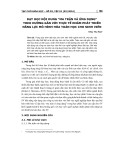

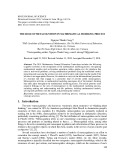

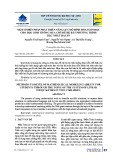
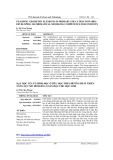
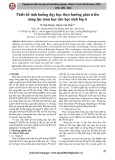
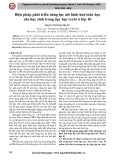
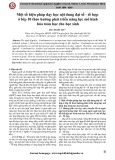
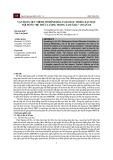
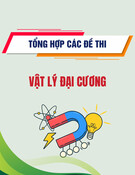
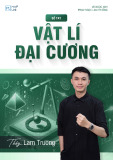
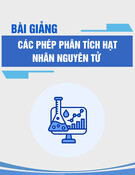
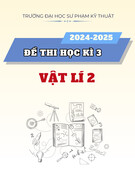
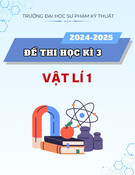
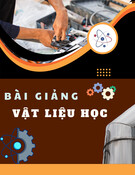
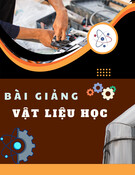
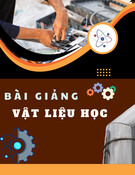
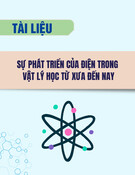
![Bộ câu hỏi lý thuyết Vật lý đại cương 2 [chuẩn nhất/mới nhất]](https://cdn.tailieu.vn/images/document/thumbnail/2025/20251003/kimphuong1001/135x160/74511759476041.jpg)
![Bài giảng Vật lý đại cương Chương 4 Học viện Kỹ thuật mật mã [Chuẩn SEO]](https://cdn.tailieu.vn/images/document/thumbnail/2025/20250925/kimphuong1001/135x160/46461758790667.jpg)




